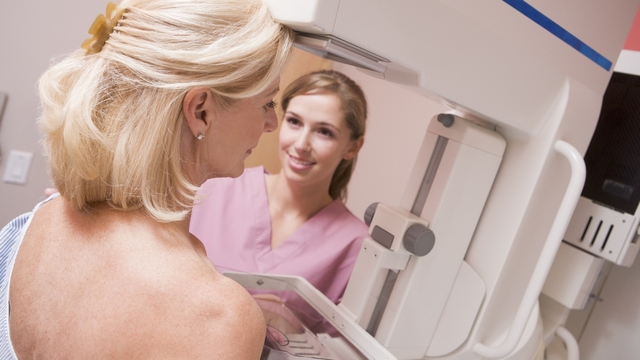 MonkeyBusiness Images/PhotoSpin
MonkeyBusiness Images/PhotoSpin
Mammograms can help reduce the number of deaths from breast cancer among women ages 40 to 70, according to the U.S. Food and Drug Administration. Nearly 90 percent of women who find and treat breast cancer are cancer-free at five years.
Still, there is misinformation surrounding this screening procedure, so here are 10 myths and facts about mammograms.
1- Myth: Mammograms are unsafe and ineffective.
Fact: Screening mammograms are the international gold standard for detecting breast cancer early. Mammograms can usually find breast lumps two or three years before they can be felt, wrote BC Cancer Agency.
2- Myth: Mammograms are inaccurate.
Fact: They are not perfect, but mammograms are the best tool for early detection. Overall, when cancer is present, mammograms are about 80 percent effective in identifying it, said the FDA.
False-negative results (when a mammogram misses a cancer) happen about 20 percent of the time. However, repeated and regular screenings reduce this percentage.
3-Myth: Finding a lump in your breast means breast cancer.
Fact: Only a small percentage of breast lumps turn out to be cancer, stated National Breast Cancer Foundation, Inc. If you have a lump, talk to your doctor. A mammogram may be needed to determine if the lump is serious or not.
4- Myth: You don’t need to get screened for breast cancer before age 40.
Fact: Since the risk of breast cancer is low, routine screening is not recommended for women under age 40.
5-Myth: Monthly breast self-exams are the best way to detect breast cancer early.
Fact: The American Cancer Society no longer recommends that women perform monthly breast self-exams. Instead it emphasizes breast awareness, which means being alert to any changes in your breasts.
6- Myth: All breast cancers can be detected on a mammogram.
Fact: No screening test is perfect, and mammography is no exception. Factors like age or breast density can influence how breast tissue looks on a mammogram, making cancers more or less difficult to recognize, wrote BC Cancer Agency.
7- Myth: Mammograms can cause breast cancer to spread.
Fact: Mammograms use very small doses of radiation. It is equivalent to getting an x-ray and the risk of harm is extremely low. Advances in technology have caused radiation doses in mammography to consistently decrease with time while consistently increasing in accuracy, said the FDA.
8-Myth: Breast compression causes cancer.
Fact: There is no scientific evidence that breast compression causes cancer. Also, breast compression while getting a mammogram cannot cause cancer to spread, said BC Cancer Agency.
9- Myth: Women with breast implants can’t get mammograms.
Fact: Women with breast implants should have regular mammograms. However, they may require special positioning and possibly some additional images.
10- Myth: Mammograms are painful.
Fact: Every woman’s threshold for pain varies widely. FDA described the compression involved in a mammogram as temporary discomfort.
Sources:
"Breast Cancer: Facts & Myths." BC Cancer Agency. N.p., n.d. Web. 14 Oct. 1924.
http://www.screeningbc.ca/Breast/FactsMyths/default.htm
"For Consumers." 4 Mammography Myths. N.p., n.d. Web. 24 Oct. 2014.
http://www.fda.gov/ForConsumers/ByAudience/ForWomen/WomensHealthTopics/ucm352291.htm
Gansler, MD, MBA, MPH, Ted. "American Cancer Society Expert Voices blog." Cancer.org. N.p., n.d. Web. 24 Oct. 2014.
http://www.cancer.org/cancer/news/expertvoices/post/2011/10/24/breast-cancer-myths-separating-fact-from-fiction.aspx
"Myths: The National Breast Cancer Foundation." www.nationalbreastcancer.org. N.p., n.d. Web. 23 Oct. 2014.
http://www.nationalbreastcancer.org/breast-cancer-myths
Reviewed October 30, 2014
by Michele Blacksberg RN
Edited by Jody Smith




Add a Comment1 Comments
When facts are called myths and myths are called facts, as is the case here, you're dealing with medical propaganda, ie deception.
The fact that mammograms are highly unsafe and exceedingly ineffective is answered with the spurious statement of some "gold standard." The gold standard of peace is the Nobel prize whose recipient is Obama who has directed to have killed hundreds of thousands of civilian lives. "Gold standard" of anything means only something important in a propaganda culture.
Medical science has long established that low dose medical xrays cause cancer, especially breast cancer (read: Rolf Hefti's "The Mammogram Myth" - more at TheMammogramMyth dot com). There are other great harms caused by it.
October 31, 2014 - 6:42amThis Comment